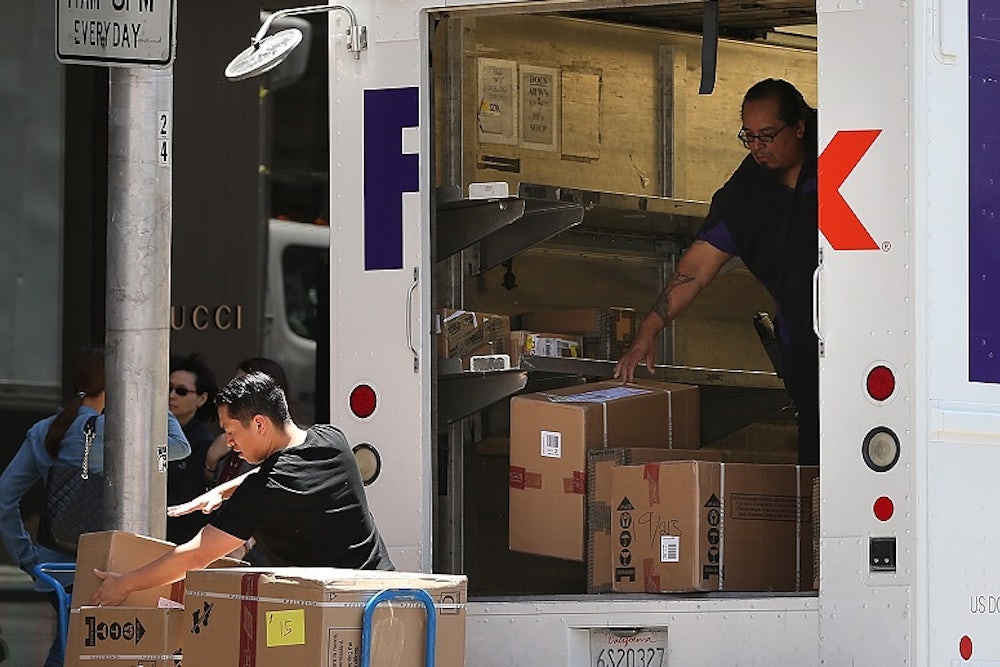FedEx exerts very tight control over its drivers. It requires them to wear a certain uniform and demands that they are clean cut. It tells them where to deliver packages, at what time do it, and how to interact with customers. The company even has something called the “little-finger” test, which requires the drivers to hook their keys onto the pinky finger of their non-writing hand after locking their trucks.
Given that FedEx dictates almost every detail of their drivers’ jobs, you would think that the shipping company employs the drivers directly. You’d be wrong. Instead, they are classified as independent contractors.
This is a classic example of employee misclassification, but such employer malfeasance is not limited to FedEx. It’s a nationwide problem that shifts significant costs to workers, eliminates employment-related protections, deprives the government of billions of dollars in revenue and prevents workers from unionizing. On Wednesday, labor earned a big victory when the Ninth Circuit Court of Appeals ruled in two cases that the shipping company misclassified the employment status of 2,300 California drivers and 363 Oregon drivers. It’s an important, if limited, step towards rectifying this widespread problem.
Employee misclassification costs workers a tremendous amount. They must purchase and maintain their own equipment. For the FedEx drivers, that meant purchasing or leasing the truck, furnishing it with company-approved equipment, and buying the proper uniform. In a traditional employer-employee relationship, the employer is generally responsible for all these costs. But under the independent contractor model, those costs are shifted to the worker.
It doesn’t end there, either. Workers don’t receive any employment-related labor law protections, like rules governing the minimum wage and overtime pay. They aren’t eligible for health and retirement benefits. Employers don’t pay premiums for worker’s compensation or unemployment insurance. Unless they pay into those premiums themselves, independent contractors who lose their contract or are hurt on the job can’t collect unemployment insurance or worker’s comp.
Since independent contractors are considered self-employed, they must pay both the employer and employee sides of their payroll taxes—a total of 12.4 percent of their income each year. Often times, misclassified workers don’t realize that they are responsible for both sides of the payroll tax. Those unpaid taxes are lost government revenue. A 2009 report by the Government Accountability Office estimated that employee misclassification cost the federal government nearly $3 billion each year. That’s not a lot compared to the entire federal budget of $3.5 trillion. But the Democrats and Republicans routinely fight over amounts much less than that. (See the recent debate over Obama's request for $3.7 billion in emergency funding for the border crisis.) In this age of deficit paranoia, every cent counts.
It may seem obvious that the FedEx workers should qualify as employees, but the courts have not always seen it that way. Between 2003 and 2009, FedEx drivers filed cases against the shipping company in approximately 40 different states, which were consolidated into one case in front of an Indiana district court. FedEx argued that, since the drivers can own the contracts formultiple routes, can profit off them, and can choose the actual directions they took delivering packages, they qualified as independent contractors. The Indiana district court ruled in favor of the shipping company.
That left the workers with a few options. They could drop their cases, negotiate a settlement in lieu of appealing, or appeal the decision. The California and Oregon classes of workers, along with 24 other classes in different states, chose to appeal to their respective state courts. Eventually, the Oregon and California cases landed in front of the Ninth Circuit and the drivers found a much more receptive audience. “The drivers must wear FedEx uniforms, drive FedEx-approved vehicles, and groom themselves according to FedEx’s appearance standards,” wrote Judge William A. Fletcher in both opinions. “FedEx tells its drivers what packages to deliver, on what days, and at what times. Although drivers may operate multiple delivery routes and hire third parties to help perform their work, they may do so only with FedEx’s consent.”
In a concurring opinion in the California case, Judge Stephen S. Trott wrote, “Labeling the drivers ‘independent contractors’ in FedEx’s Operating Agreement does not conclusively make them so.”
It’s difficult to predict the implications of this case. FedEx plans to appeal the case to the full Ninth Circuit, instead of just the three-judge panel that decided these cases. California and Oregon each have their own specific labor laws that the court used to base their opinions. In other cases, the respective state law will take precedent. But Catherine Ruckelshaus, general counsel of the National Employment Law Project, believes that the California case could still have far-reaching effects. “The California law is quite narrow and really doesn’t cover that many workers,” she said. “The fact that this court found that these drivers are employees means…that other courts applying the broader tests are also going to find—or should also find—that [other drivers] are covered.”
“I think the impact will be felt outside of FedEx,” said Aaron Kaufmann, one of the attorneys for the drivers in the California case. “It’s sort of a trucking industry standard to use this independent contractor model. I think this decision will be wake up call.”
